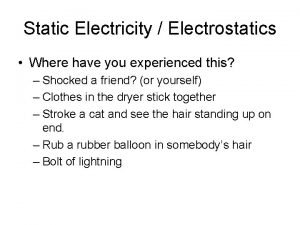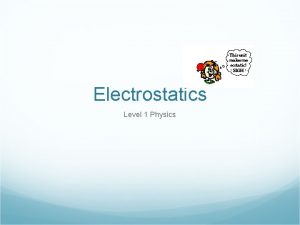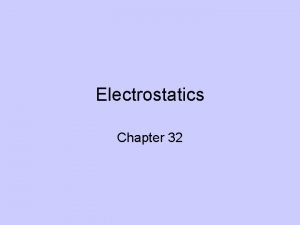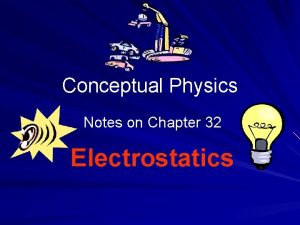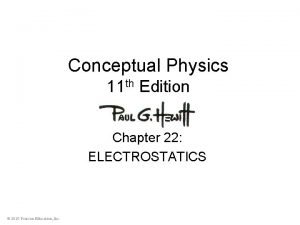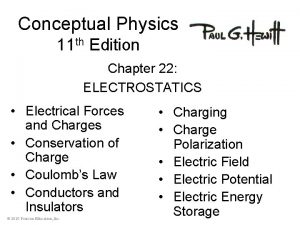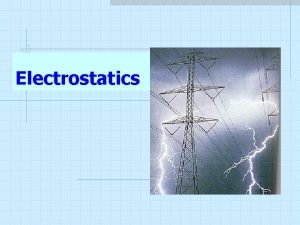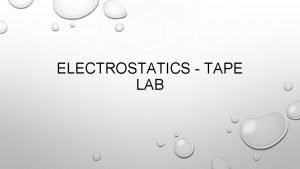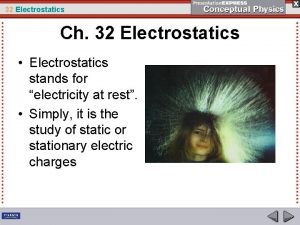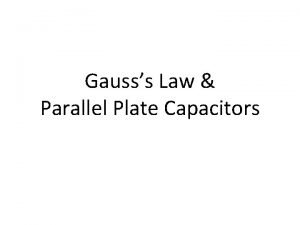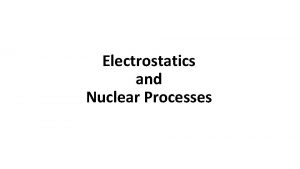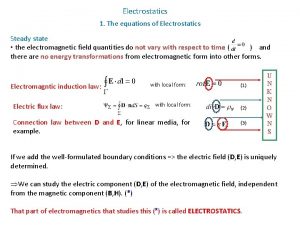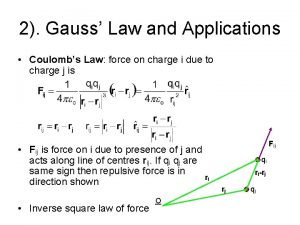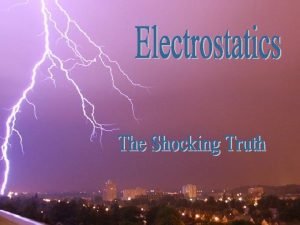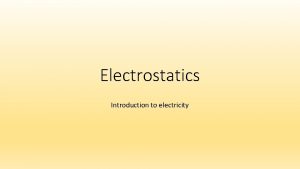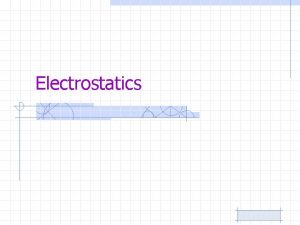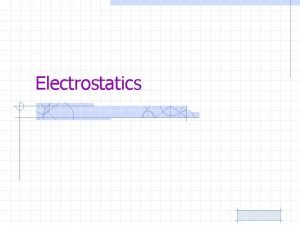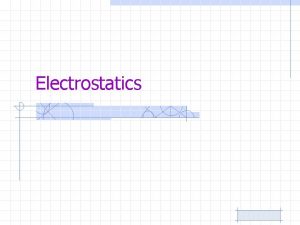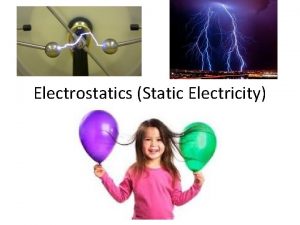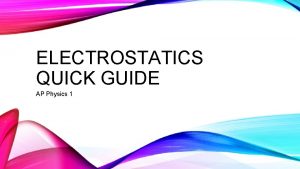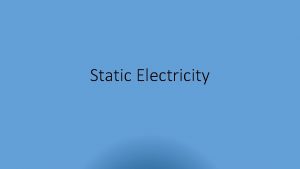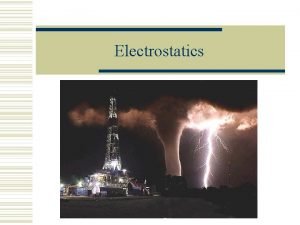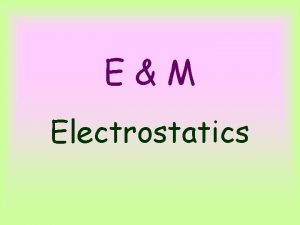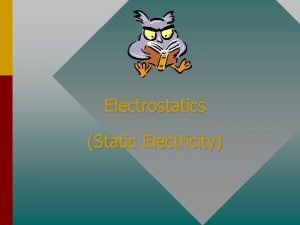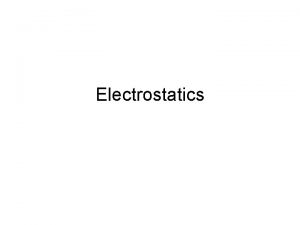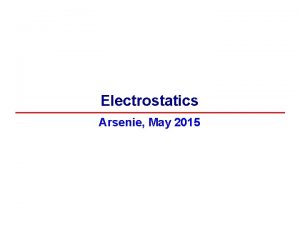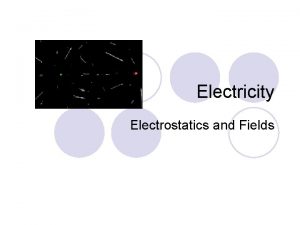Electrostatics and Electricity Electrostatics Electrostatics is the study


















- Slides: 18

Electrostatics and Electricity

Electrostatics • Electrostatics is the study of electric charge • Electric Charge-is described as electron movement. Electrons can transfer from one object to another • Two types of charges + and – • Like charges_____ • Opposite charges____ • How objects become electrically charged is by transfer of electrons

• There are two types of electron transfer • Conduction- is process of charging a neutral body by touching it with a charged object • Induction-process of a charge induced by close proximity to the charged object • Electroscope- is a device that detects electric charges

• Conductor – is a material in which electrical charges flow easily (ex. _______) • Insulator – is a material in which electrical charges do not flow easily (ex. ______) • Polarization – the process of rearranging the charges already present on an object to create a temporary charge

Lightning


Van de Graff Generator

Coulomb’s Law • Coulomb’s Law – the magnitude of electric force between two charges is directly proportional the magnitude of the charges and inversely proportional to the square of the distance between the charges.

Coulomb’s Law Cont. • * a negative force means they were attracting charges • *a positive force means they were repelling charges • *Coulomb’s Constant =KC= 8. 99 x 109 Nm 2/C 2

• Coulomb’s Law Cont. An electron with a charge of 1. 60 x 10 C is. 10 m -19 from a proton with a charge of 1. 60 x 10 -19 C. What is the electric force between the two charges? Felect =? ? ? Q 1 = - 1. 60 x 10 -19 Q 2 = 1. 60 x 10 -19 d =. 10 m

• Coulomb’s Law Cont. Two balloons are charged with an identical quantity and type of charge: -6. 25 x 10 -9 C. They are held apart at a separation distance of. 617 m. Determine the magnitude of the electrical force of repulsion between them.

Circuit Schematics • Schematic – a diagram that uses symbols for components of an electrical circuit

Types of Circuits • Series circuit – all current travels through each electrical component in one path (ex. Christmas lights) • Series formulas • VT = V 1+V 2+V 3…. . • IT = I 1=I 2=I 3…. . • RT = R 1+R 2+R 3…. .

Types of Circuits • Parallel circuit – a circuit with several paths of current • Parallel formulas • VT = V 1=V 2=V 3…. . • IT = I 1+I 2+I 3…. . • 1/RT = 1/R 1+1/R 2+1/R 3…. .

Ohm’s Law • Electric current – the flow of charge. • Electrons flow around a closed loop called a circuit • Electric current is measured in amperes (amps; 1 A=1 amp) • The symbol of current in the equation is I

Ohm’s Law • Voltage – the potential difference in electric charge. • Voltage is measured in volts (V) • The symbol for voltage is V

Ohm’s Law • Resistance – property that determines how much current will flow through a circuit • Resistance is measured in ohms (Ω) • The symbol for resistance is R in the equation • All conductors offer some resistance

Ohm’s Law • I=V/R; this is relationship ohm discovered • V=IR
 Static electricity and current electricity
Static electricity and current electricity Current electricity gif
Current electricity gif Electricity and magnetism vocabulary
Electricity and magnetism vocabulary Electric energy
Electric energy Electrostatics equations
Electrostatics equations Induction vs conduction
Induction vs conduction This is electricity at rest
This is electricity at rest Chapter 32 conceptual physics
Chapter 32 conceptual physics Conceptual physics chapter 22: electrostatics answers
Conceptual physics chapter 22: electrostatics answers Conceptual physics chapter 22 electrostatics
Conceptual physics chapter 22 electrostatics What is electrostatics
What is electrostatics Static electricity tape lab
Static electricity tape lab Electrostatics
Electrostatics Electrostatics
Electrostatics Facts about electrostatics
Facts about electrostatics Physics classroom electrostatics
Physics classroom electrostatics Electrostatics
Electrostatics Gauss law in integral form
Gauss law in integral form Induction vs conduction
Induction vs conduction



